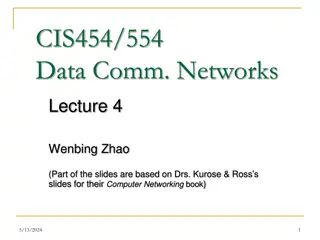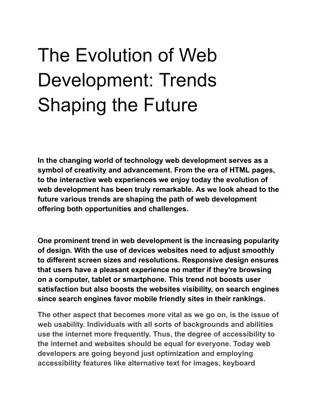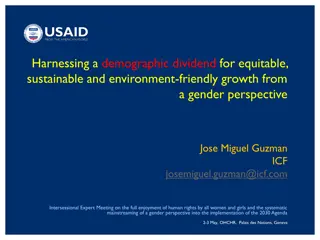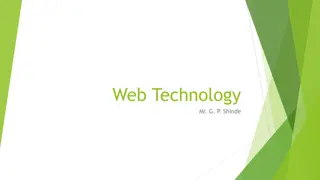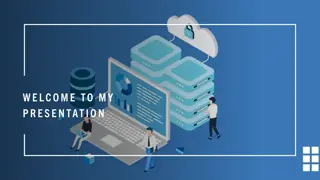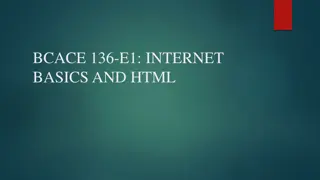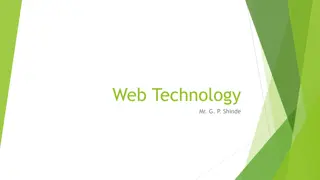
EMPOWERING THE WEB_ HARNESSING TECHNOLOGY TO CREATE IMPACTFUL EXPERIENCES
Web empowerment refers to the power that the web provides for individuals to express themselves, influence others, and affect the course of society.
Download Presentation

Please find below an Image/Link to download the presentation.
The content on the website is provided AS IS for your information and personal use only. It may not be sold, licensed, or shared on other websites without obtaining consent from the author. If you encounter any issues during the download, it is possible that the publisher has removed the file from their server.
You are allowed to download the files provided on this website for personal or commercial use, subject to the condition that they are used lawfully. All files are the property of their respective owners.
The content on the website is provided AS IS for your information and personal use only. It may not be sold, licensed, or shared on other websites without obtaining consent from the author.
E N D
Presentation Transcript
Web empowerment refers to the power that the web provides for individuals to express themselves, influence others, and affect the course of society. WHAT IS THE IMPORTANCE OF USING WEB TECHNOLOGIES? Technology is imperative in web development as it forms the groundwork of building websites and web applications. The right technology heightens efficiency, security, and scalability, leading to a superior user experience. They enable web applications to manage complex tasks, processive massive amounts of data, and deliver seamless user experiences. EXPLAIN THE EVOLUTION OF WEB TECHNOLOGY. Web technology is the use of hypertext markup language (HTML) and cascading style sheets (CSS). . Categorized into generations, from Web 1.0 to Web 5.0, the web s progress symbolizes a major shift in technology and usage. Web 1.0 consists of read-only pages, while Web 2.0 enables social networking and user-generated content. WHAT IS THE CONCEPT OF MOBILE WEB? The mobile web is the use of the internet through mobile devices like smartphones and tablets. Mobile internet use bypassed regular forms of internet access back in 2014 and has only been increasing since Feb 2022. Access to the mobile web was first commercially offered in 1996, in Finland, on the Nokia 9000 communicator phone via the Radiolinja networks. The first commercial launch of a mobile-specific browser-based web service was in 1999 in Japan when i-mode was launched by NTT DOCOMO. WHAT IS CLOUD COMPUTING SERVICES? Cloud computing refers to the internet-based computing systems used to deliver applications between computers through the internet. It is the delivery of computing services- including servers, storage, databases, networking, software, analytics, and intelligence over the Internet to offer faster innovation, flexible resources, and economies of scale. Consumers and businesses can use the cloud to store data and applications and can interact with the cloud using mobiles, desktop computers, laptops, etc. WHAT ARE TYPES OF CLOUD COMPUTING SERVICES? There are three types of cloud computing services: public cloud, private cloud, and hybrid cloud. Within these deployment models, there are four main services: infrastructure as a service (las), platform as a service (PaaS), software as a service (SaaS), and serverless computing.
WHAT ARE THE CORE TECHNOLOGIES EMPOWERING THE WEB? Core technology means any technology owned or licensed by a licensor that may be combined with the Licensee s technology for sale as the product . It is an intravascular, intraluminal, or intertissued miniature magnetic resonance coil detection as described in the patent rights. FOLLOWING ARE THE CORE TECHNOLOGIES EMPOWERING THE WEB: 1. FRONT-END TECHNOLOGIES Front-end refers to user-facing components of a website or application, created using technologies like HTML, CSS, and Javascript. . A front-end developer creates websites and applications using languages such as HTML, and JAVASCRIPT that allow users to access and interact with the site or app. IMPACT OF FRONT-END Front-end development works with the UX team to help add new features to a website or improve the current usability of a design. Some of the front-end technologies are: A. HTML5, CSS3, JAVASCRIPT HTMML5- defines the structure of the content, CSS determines the style and layout and javascript makes the content interactive: therefore it makes more sense to learn them in order. Javascript incorporates valuable skills such as object-oriented, functional, and imperative styles of programming. B. RESPONSIVE AND ADAPTIVE DESIGN Responsive design works well for larger sites that are being built from scratch. Whereas adaptive design works well for smaller sites that are being refreshed..it relies on changing the design pattern to fit the real estate available to it, adaptive design has multiple fixed layout sizes. When the site detects the available space, it selects the layout most appropriate for the screen. 2. BACK-END TECHNOLOGIES Back-end technologies refer to the programming languages used in web development to create and manage a website or application. They are responsible for the behind the scenes work, like storing data, managing user authentication, and providing APIs for front-end applications. IMPACT OF BACKEND
Backend technologies play a polar part in formative the performance, security, and functionality of applications. Their scalability, performance, and API support collectively bestow to creating a robust and reliable backend infrastructure. Some of the back-end technologies are: A. SERVER-SIDE LANGUAGES Server-side languages play a vital role in modern web development, empowering developers to create dynamic and interactive websites. They provide the means to process user requests, interact with databases, and generate personalised content. They allow one to instead store the information in a database and dynamically construct and return HTML and other types of files. B. DATABASES (SQL, NoSQL) The database hives away information about the users, products, orders, and more. A database is an essential component of any web application because it provides a central location for sorting user information and business logic. C. APIs AND MICROSERVICES Microservices are an architectural approach that composes software into small, independent, highly specialised services. Each microservice solves a single problem or performs a specific task. In contrast, an API is a contract of communication between two software components. 3. EMERGING TECHNOLOGIES Emerging technologies are technologies whose development, and practical applications are both still largely unrealized. These technologies are generally new but also include older technologies finding new applications. They are often perceived as capable of changing the status quo. some of the emerging technologies are: A. ARTIFICIAL INTELLIGENCE (AI ) AND MACHINE LEARNING (ML) AI in web development is often used for automatic user behaviour analysis. using AI-powered recommendation systems, one may attract visitors by offering them an engaging user experience. B. AUGMENTED REALITY (AR) AND VIRTUAL REALITY(VR) Augmented reality or AR involves the consolidation of digital components into the real world, augmenting the user's sensory experience. On the flip side, virtual reality or VR engulfs users in entirely virtual environments, offering a complete departure from the physical world.
C. BLOCKCHAIN AND DECENTRALISED WEB Blockchain is a decentralised and distributed digital technology that is used for recording transactions across many computers so that the records cannot be altered by someone without changing the subsequent blocks and without the consequence of networks. In web development, blockchain is a method of recording information that makes it impossible or difficult for the system to be changed, hacked, or manipulated. It is a distributed ledger that duplicates and distributes transactions across the network of computers participating in the blockchain. In conclusion, the empowerment of the web through the harnessing of cutting-edge technology has Fundamentally transformed how impactful experiences are created and delivered. The evolution from static web 1.0 pages to the dynamic, interactive, and intelligent web environments one experiences today highlights the significant strides made in web technologies. For more info Bigcommerce development Services in usa



